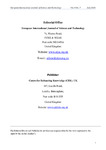| dc.contributor.author | Noor-e-Huma | |
| dc.contributor.author | Akram, Nadia | |
| dc.contributor.author | Naz, Rabia | |
| dc.date.accessioned | 2020-12-17T07:39:49Z | |
| dc.date.available | 2020-12-17T07:39:49Z | |
| dc.date.issued | 2020-07 | |
| dc.identifier.issn | 2304-9693 | |
| dc.identifier.uri | http://ir.mksu.ac.ke/handle/123456780/7682 | |
| dc.description.abstract | Cookies are an easy to go snacks with an increasing demand owing to their ease of consumption in
this era of changed dietary patterns and sedentary life style. The effect of clove substitution in
carrot flour cookie was assessed. The carrot flour being a good source of high fiber and low-calorie
ingredient was used to assess the organoleptic properties of the cookies. The composite flour
consists of carrot flour and white flour in two different ratios as; 50:50% (CF1) and 70:30 % (CF2),
respectively with 2.5g of clove added to each. The best selected ratio after sensory evaluation was
first analyzed for its nutritional composition, standardized for a replicable model and tested for the
proximate estimation. Proximate analysis revealed a considerable change in crude protein (6.60%
to 9.46%), crude fiber (4.10% to 5.80%). Clove incorporation improved the sensory quality of
composite flour cookies and can open new opportunities for development of functional products
with added health benefits specifically the snack items like cookies. | en_US |
| dc.language.iso | en_US | en_US |
| dc.publisher | European International Journal of Science and Technology | en_US |
| dc.subject | Clove | en_US |
| dc.subject | Nutritional composition | en_US |
| dc.subject | Proximate analysis | en_US |
| dc.subject | Therapeutic value | en_US |
| dc.subject | Aromatic plant | en_US |
| dc.subject | Beta-carotene | en_US |
| dc.subject | Carrot flour | en_US |
| dc.title | Use of Clove Carrot Mix in Cookies; A Way Towards Development of Low Caloric and High Fiber Cookies with Improved Organoleptic Properties | en_US |
| dc.type | Article | en_US |

